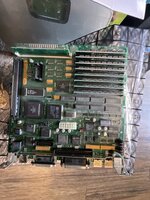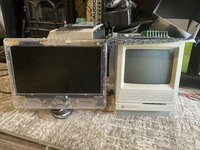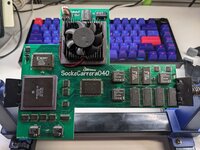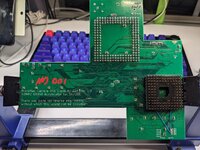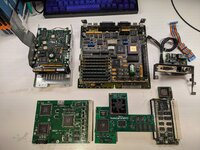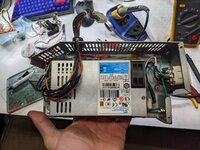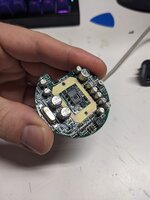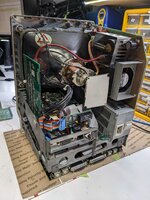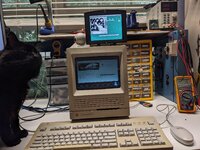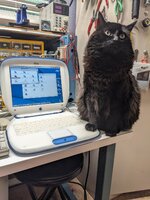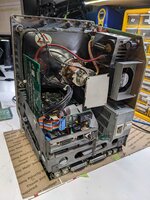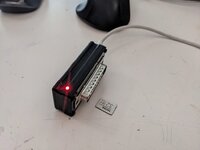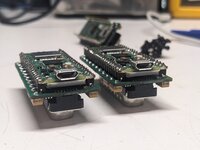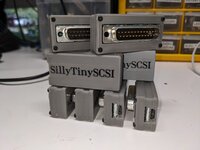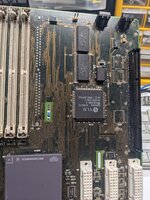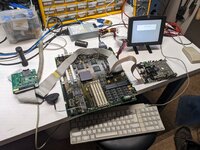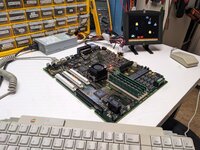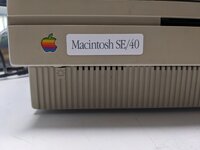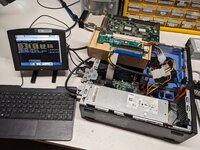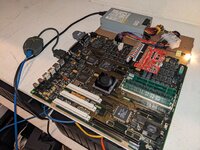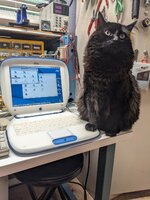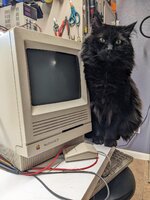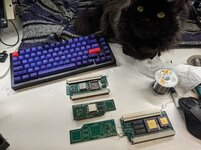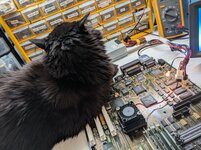zigzagjoe
Well-known member
Figured I'd throw a thread together for my (mostly SE/30-related) nonsense.
Background: Many of my vintage machines came from Goodwill back in 2004 - even still have the original stickers from these two SE/30s for $20! But they'd sat idle on my shelf since 2005 or so, and it was time to either fix all my vintage stuff or get rid of them. Thankfully, I had removed the batteries - unfortunately, along with most fasteners, the RF shields, HDD caddys and cables being lost too.
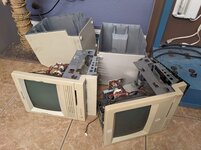
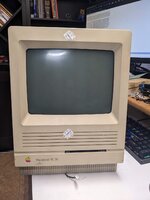
With a round of recapping and dealing with the ravages of capacitor juice (dramatic simplification), both were once again functional. I was prepared to settle for one, but both was a bonus. I replaced the gear in both floppies - they were of a spreadable consistency. ABs and PSUs both were recapped despite working fine - no sense waiting for them to fail.
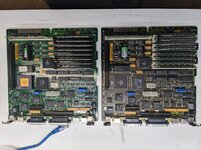
Both LBs needed a couple of bodges... the left board needed the ASC and SCSI chips resoldered and UE8 replaced. The right, SCSI needed a resolder job, and the audio amplifier section had to be entirely rebuilt as several parts had rotted off the board. Later, I cleaned them up further, replaced the 12v rail caps with 25v rated ones, and was able to remove the bodges on the left in favor of trace repairs.
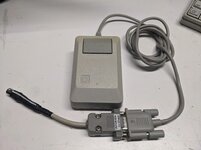
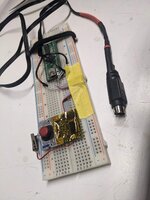
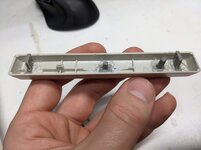
Along the way were some horrific experiments in being a cheapskate with peripherals: An Apple II mouse to ADB adapter (not actually sure why I had an apple II mouse. I've never had one.). A trackpoint to ADB adapter. And a replacement spacebar for an AEK II, from an appledesign donor with 3D printed bits.
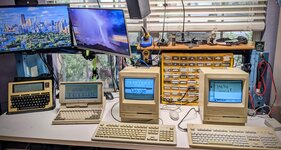
All working!!! With some replacement parts from ebay and a local Mac preservationist, I now have two happy SE/30s:
#1 - 128MB of vintage mitsubishi RAM (from goodwill!), a farallon NIC and 2GB IBM HDD
#2 - 20MB of vintage RAM, not much else. An external bluescsi to allow it to do something other than boot off a floppy.
(along with my Tandy 102 and Toshiba T1200 that were fixed up along the way)
So the question was, what next, what now? I'm fiddling with my macs again, and that's great, but I really want to tinker on hardware! Somehow, I convinced myself that I'd make the poor decision to try to build the "ideal" setup of grayscale + asante w/ removable AUI + socketted accelerator. I'd had a IIsi previously, and it was notably snappier - but it'd be fun to have one machine that can do both! And hopefully, run A/UX too. Of course, this is all easier said than done....
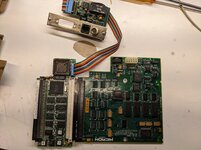
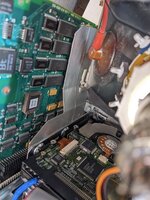
Easiest to come by was the Asante Maccon 30ie - a straightforward if not inexpensive ebay find. Replace the connector with a right angle, and we're stackable. Later, I added a pull-up on the CPU clock signal as it was being drawn down with both cards, causing bus errors.
Next up with the Micron Xceed Color 30, which was a Buyee find. Not being satisfied with the fixed VGA resolution, I hacked on the 30HR ROM to make it work with the older ASIC to gain the additional resolution support. In effect, it is now a Color 30HR. Later, I got the original Micron code into a buildable state, adding a workaround for the grayscale setup not working with A/UX. I made a metal bracket out of the remains of a Dell PSU to act as both a support and EMI shield to protect the Xceed card.
The final piece of the puzzle was the hardest: The (fabled?) Socketted Daystar Powercache. I did not see one of these come up for sale, and still haven't, aside from a Bolle clone. However, Bolle was so kind as to post the schematics and GAL equations for the DiimoCache ... PDS being what it is - there's no reason I couldn't remake it in a socketted form-factor.... right?
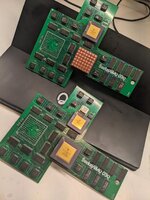
Right. So, that happened. I redrew the schematics in Kicad, (poorly) routed them with Freerouting's help (then spent a day fixing its mess), then had the boards made at Jlcpcb. Built them up and it works great! These (and presumably the original Diimo) even work under A/UX if you load the control panel to enable cache prior to A/UX boot.
After this came the quest for more speed: I wanted to get it to 60mhz. I settled with upgrading #1 to 58mhz CPU & FPU with 128KB of cache, where the original design being 50mhz CPU, 25mhz FPU, and 64KB cache. Not bad! Faster than anything else with a 68030, for sure.
So this completed SE/30 #1.
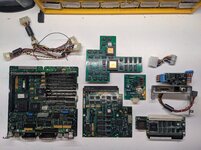
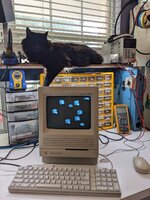
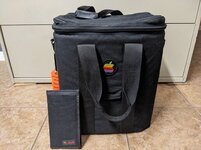
Along the way, a friend gave me a steal on a IIgs keyboard, and I got some nice deals on a West Ridge Designs carrying bag and floppy wallet. The carry bag being complete with a vintage tag proclaiming it to be Northwest Airlink Carry On Baggage. With a 3D-printed replacement foot, it's ready to fly again, though it's now too wide to be compliant
Finding myself at loose ends, I turned to some software tinkering, until I came across this on Buyee: An Interware GrandVimage 24-21s. Buyee would not allow you to bid on it, as per the auction description the seller would delete bids from Zenmarket and probably the other auction proxy sites. However, I was able to use Treasure Japan to bid on the auction. Nahoko Yamada was great to deal with and eventually I had the card in hand.
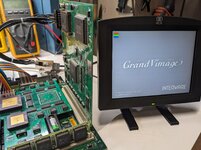
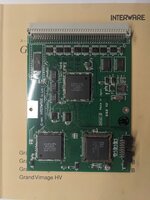
What fun! This card is great. I believe it's the most capable video card (and probably one of the last...) made for the SE/30. It features quickdraw acceleration and will do 1152x870 at 24 bit or 1280x1024 at 8 bit. Not bad for $90!!
I had been flirting with the idea of getting rid of the second SE/30, but clearly I need to keep it for this card. The machine needs a niche... what's it going to be? Further shenanigans are planned :]
Background: Many of my vintage machines came from Goodwill back in 2004 - even still have the original stickers from these two SE/30s for $20! But they'd sat idle on my shelf since 2005 or so, and it was time to either fix all my vintage stuff or get rid of them. Thankfully, I had removed the batteries - unfortunately, along with most fasteners, the RF shields, HDD caddys and cables being lost too.


With a round of recapping and dealing with the ravages of capacitor juice (dramatic simplification), both were once again functional. I was prepared to settle for one, but both was a bonus. I replaced the gear in both floppies - they were of a spreadable consistency. ABs and PSUs both were recapped despite working fine - no sense waiting for them to fail.

Both LBs needed a couple of bodges... the left board needed the ASC and SCSI chips resoldered and UE8 replaced. The right, SCSI needed a resolder job, and the audio amplifier section had to be entirely rebuilt as several parts had rotted off the board. Later, I cleaned them up further, replaced the 12v rail caps with 25v rated ones, and was able to remove the bodges on the left in favor of trace repairs.



Along the way were some horrific experiments in being a cheapskate with peripherals: An Apple II mouse to ADB adapter (not actually sure why I had an apple II mouse. I've never had one.). A trackpoint to ADB adapter. And a replacement spacebar for an AEK II, from an appledesign donor with 3D printed bits.

All working!!! With some replacement parts from ebay and a local Mac preservationist, I now have two happy SE/30s:
#1 - 128MB of vintage mitsubishi RAM (from goodwill!), a farallon NIC and 2GB IBM HDD
#2 - 20MB of vintage RAM, not much else. An external bluescsi to allow it to do something other than boot off a floppy.
(along with my Tandy 102 and Toshiba T1200 that were fixed up along the way)
So the question was, what next, what now? I'm fiddling with my macs again, and that's great, but I really want to tinker on hardware! Somehow, I convinced myself that I'd make the poor decision to try to build the "ideal" setup of grayscale + asante w/ removable AUI + socketted accelerator. I'd had a IIsi previously, and it was notably snappier - but it'd be fun to have one machine that can do both! And hopefully, run A/UX too. Of course, this is all easier said than done....


Easiest to come by was the Asante Maccon 30ie - a straightforward if not inexpensive ebay find. Replace the connector with a right angle, and we're stackable. Later, I added a pull-up on the CPU clock signal as it was being drawn down with both cards, causing bus errors.
Next up with the Micron Xceed Color 30, which was a Buyee find. Not being satisfied with the fixed VGA resolution, I hacked on the 30HR ROM to make it work with the older ASIC to gain the additional resolution support. In effect, it is now a Color 30HR. Later, I got the original Micron code into a buildable state, adding a workaround for the grayscale setup not working with A/UX. I made a metal bracket out of the remains of a Dell PSU to act as both a support and EMI shield to protect the Xceed card.
The final piece of the puzzle was the hardest: The (fabled?) Socketted Daystar Powercache. I did not see one of these come up for sale, and still haven't, aside from a Bolle clone. However, Bolle was so kind as to post the schematics and GAL equations for the DiimoCache ... PDS being what it is - there's no reason I couldn't remake it in a socketted form-factor.... right?

Right. So, that happened. I redrew the schematics in Kicad, (poorly) routed them with Freerouting's help (then spent a day fixing its mess), then had the boards made at Jlcpcb. Built them up and it works great! These (and presumably the original Diimo) even work under A/UX if you load the control panel to enable cache prior to A/UX boot.
After this came the quest for more speed: I wanted to get it to 60mhz. I settled with upgrading #1 to 58mhz CPU & FPU with 128KB of cache, where the original design being 50mhz CPU, 25mhz FPU, and 64KB cache. Not bad! Faster than anything else with a 68030, for sure.
So this completed SE/30 #1.



Along the way, a friend gave me a steal on a IIgs keyboard, and I got some nice deals on a West Ridge Designs carrying bag and floppy wallet. The carry bag being complete with a vintage tag proclaiming it to be Northwest Airlink Carry On Baggage. With a 3D-printed replacement foot, it's ready to fly again, though it's now too wide to be compliant
Finding myself at loose ends, I turned to some software tinkering, until I came across this on Buyee: An Interware GrandVimage 24-21s. Buyee would not allow you to bid on it, as per the auction description the seller would delete bids from Zenmarket and probably the other auction proxy sites. However, I was able to use Treasure Japan to bid on the auction. Nahoko Yamada was great to deal with and eventually I had the card in hand.


What fun! This card is great. I believe it's the most capable video card (and probably one of the last...) made for the SE/30. It features quickdraw acceleration and will do 1152x870 at 24 bit or 1280x1024 at 8 bit. Not bad for $90!!
I had been flirting with the idea of getting rid of the second SE/30, but clearly I need to keep it for this card. The machine needs a niche... what's it going to be? Further shenanigans are planned :]
Last edited:

